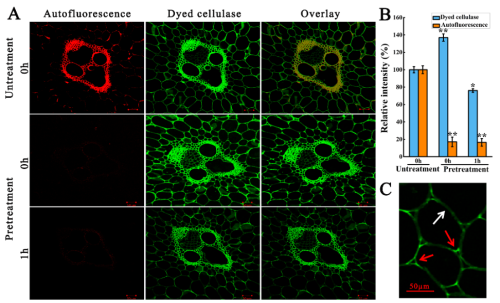Researchers from the Institute of Modern Physics (IMP) of the Chinese Academy of Sciences have made progress in the study of enzymatic hydrolysis process of alkali pretreated straw lately.
Lignocellulose is one of the most abundant biomass resources. The technique of enzymatic hydrolysis is the key to efficient bioconversion of lignocellulose. It remains unclear whether the mechanism of lignin affects enzyme digestibility by a physical barrier on the cellulose surface or by the nonproductive binding to enzyme. In addition, the detailed digestion manner of plant cell walls by cellulase were not studied previously.
Therefore, the study of efficient pretreatment and the visualization of enzymatic hydrolysis to plant cell walls will be greatly helpful to enhance the biomass processing efficiency.
Researchers from the Biophysics Laboratory of IMP rescently have studied the pretreatment effectiveness and the enzymatic hydrolysis manner of plant cell walls.
Scientists found that the pretreatment of sweet sorghum straw (SSS) with dilute alkali, dilute acid and hydrogen peroxide enhanced the efficiency of enzymatic hydrolysis, and it was improved to 86.44% with alkali pretreatment.
Furthermore, the real-time imaging analysis and the confocal laser scanning microscopy (CLSM) coupled with fluorescent-labeling techniques were used to study the visualization of enzymatic hydrolysis process.
During the course of hydrolysis, researchers found that the cellulase dissolved the cell walls in the same manner and the digestion firstly occurred from the middle of cell walls and then toward its corners. The overall digestibility was negatively correlated with the lignin contents of SSS.
The CLSM coupled with fluorescent labeling demonstrated that the vascular bundles in natural SSS were highly lignified, and the effect of lignin on enzyme digestibility was attributed to the nonproductive bindings of cellulase to lignin. While the efficient delignification was achieved by alkali pretreatment process, which reduced the nonproductive bindings of cellulase on lignin, thereby the saccharification efficiency was improved.
The research provides insight into the structural changes and visualization of the hydrolysis process. These findings will help to design plant cell structures and plant tissues at the organization level, and reduce the natural recalcitrance of lignocellulose, thereby enhancing the overall biomass conversion efficiency.
This work was done by a team led by WANG Shuyang of Institute of Modern Physics. DONG Miaoyin was the first author of this paper. The article was published in Biotechnology for Biofuels.
This work was supported by the key projects of the Chinese Academy of Sciences.
Link to the paper: https://doi.org/10.1186/s13068-019-1613-6

Figure 1. Alkali-pretreated sweet sorghum straw imaged in real time during enzymatic hydrolysis. (Image by DONG Miaoyin)

Figure 2. The CLSM images of autofuorescence and dye-labeled fuorescence of cell walls with or without alkali pretreatment. (Image by DONG Miaoyin)
Contact :
LIU Fang
Institute of Modern Physics
Email: fangliu@impcas.ac.cn

